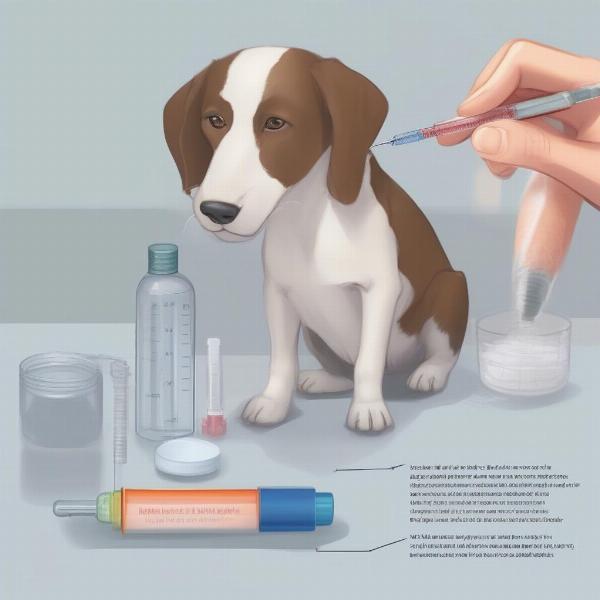Administering insulin to your dog can be daunting, especially at first. Understanding the proper use of insulin needles is crucial for managing your dog’s diabetes effectively. This guide provides valuable information on insulin needles for dogs, including selection, preparation, and safe injection techniques.
Choosing the Right Insulin Needle for Your Dog
Selecting the appropriate needle size is essential for your dog’s comfort and the effectiveness of the insulin. The gauge (thickness) and length of the needle are key factors. A smaller gauge number indicates a thicker needle. Veterinarians typically recommend using 29-31 gauge needles for dogs, with 29 gauge being the most common. Shorter needles, like 5/16″ or 1/2″, are preferable to minimize discomfort and ensure the insulin is delivered subcutaneously (under the skin). Your veterinarian can help you determine the ideal needle size and gauge based on your dog’s size and breed. Remember, never reuse needles.
Preparing the Insulin and Needle
 Preparing an insulin injection for a dog
Preparing an insulin injection for a dog
Before injecting insulin, ensure you have the correct insulin dosage prescribed by your vet. Wash your hands thoroughly and gently roll the insulin vial between your palms to mix it, avoiding vigorous shaking. Remove the cap from the needle and carefully draw the prescribed amount of insulin into the syringe. Check for air bubbles and gently tap the syringe to remove them, pushing any excess insulin back into the vial. Cap the needle until ready for injection.
How to Give a Subcutaneous Insulin Injection
insulin pen for dogs are becoming increasingly popular. However, if you are using traditional needles, injecting insulin subcutaneously is crucial for proper absorption. This means injecting the insulin just under the skin, not into the muscle. The best locations for subcutaneous injections are the loose skin on the back of the neck, between the shoulder blades, or along the flanks (sides of the body).
- Tent the skin: Gently pinch a fold of skin to create a “tent.”
- Insert the needle: Insert the needle at a 45-degree angle into the tented skin.
- Inject the insulin: Slowly and steadily inject the insulin.
- Withdraw the needle: Withdraw the needle and gently release the skin.
Addressing Common Concerns about Insulin Needles
Many dog owners worry about hurting their dogs with injections. Choosing the right needle size and injecting correctly minimizes discomfort. Most dogs adapt quickly to regular injections, especially when paired with positive reinforcement like treats and praise.
What if I accidentally inject into the muscle?
Intramuscular injection can cause faster insulin absorption and potential hypoglycemia (low blood sugar). If you suspect you’ve injected into the muscle, monitor your dog closely for signs of hypoglycemia, such as weakness, trembling, and seizures, and contact your veterinarian immediately.
Maintaining Hygiene and Safety
Always use a new, sterile needle for each injection. Never reuse needles. Dispose of used needles safely in a sharps container, which can be obtained from your veterinarian or pharmacy.
Where can I buy insulin syringes for dogs?
syringe for dogs and insulin syringes dogs can be purchased from your veterinarian, local pharmacies, and online pet supply stores.
Conclusion
Understanding how to use insulin needles correctly is vital for managing your dog’s diabetes. By following these guidelines and working closely with your veterinarian, you can ensure your dog receives the proper insulin dosage safely and comfortably. Remember, consistent insulin administration, combined with a balanced diet and regular exercise, can help your diabetic dog live a happy and healthy life.
FAQ
- How often should I change my dog’s insulin needles? Always use a new needle for each injection.
- What should I do if my dog resists the injections? Try positive reinforcement techniques like treats and praise. Talk to your vet if the resistance continues.
- Can I use a human insulin syringe for my dog? It’s best to use insulin syringes specifically designed for pets, as the dosage markings may differ.
- Where can I dispose of used needles? Dispose of used needles in a designated sharps container.
- What are the signs of hypoglycemia in dogs? Weakness, trembling, seizures, and disorientation are common signs of low blood sugar.
- How do I store insulin? Store unopened insulin in the refrigerator. Opened insulin can be stored at room temperature, away from direct sunlight and heat.
- What is the best injection site for my dog? Consult with your veterinarian to determine the ideal injection site for your dog. Common sites include the scruff of the neck, between the shoulder blades, or the flanks.
ILM Dog is a leading online resource dedicated to providing dog owners worldwide with reliable and practical advice on all aspects of dog care, including breed information, health, training, nutrition, grooming, and more. Our mission is to empower dog owners with the knowledge and resources they need to nurture happy and healthy canine companions. Whether you’re a seasoned dog owner or just starting your journey, ILM Dog offers expert guidance and valuable insights to help you navigate the world of dog ownership. For professional advice and assistance, contact us at [email protected] or call us at +44 20-3965-8624. Learn more about us at ILM Dog.
subcutaneous injection sites in dogs provides further guidance on where to inject insulin in your dog.